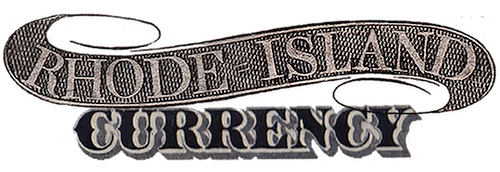Grocers & Producers Bank, Providence
As noted in 1891:
“The Grocers’ and Producers’ Bank was incorporated in May, 1854, with a capital of $100,000. A. B. Dike was president until 1856; John R. Balch, 1856 to 1858; Esek Tallman, 1858 to 1878. Thomas T. Doyle was cashier from the starting- until 1855; William J. Dexter, to 1857; H. J. Steere, to 1858; D. K. Hoxsie. to 1870; E. F. Phillips, to 1875; J. B. Calder, to 1878. The first directors were A. B. Dike. Welcome Fenner, Godfrey Work, George W. Buffington, P. W. Gardner, Esek Tallman. George H. Whitney, J. S. Harris, N. G. Hoxsie and Dexter Daniels. The bank was located at 82 Westminster street; in 1857 at 38 Weybosset; in 1859 at 50 Westminster; in 1866 at 62 Westminster, remaining there until 1878. The stock capital at that time was $160,000, and the directors were Esek Tallman, A. B. Dike, D. K.. Hoxsie, Godfrey Work. E. F. Phillips, Sullivan Moulton and William Barton.” — Richard M. Bayles, ed. History of Providence County, Rhode Island, Volume I. New York: W. W. Preston, 1891.
In September of 1878, the bank’s accounts came up short. Suspicion quickly fell upon Grocers’ young cashier, John B. Calder. On October 2nd, The Providence Evening Press reported that Calder had confessed to mismanaging the institution’s funds:
“He did not know how much he had stolen, but said that to assist ‘friends’ to tide over the hard time he had permitted them to overdraw their accounts. He began this dishonest practice about three years ago, first taking small sums and then increasing amounts, the largest sums being taken within a year. A running account of $25,000 was kept in the New York and Boston banks, and whenever Calder wanted money he would draw on these banks, but would neglect to enter the sums on the deposit books kept here. Thus the books at times would show a good balance when there would not be a dollar to the credit of the Grocers and Producers’ Bank on deposit.
“Another method of Calder’s was the manipulation of the accounts of the largest depositors, which it appears was carried to a terrible extent. Depositors who had an account of $15,000 Calder would manipulate so that the books would show but $6000 to their credit, pocketing the difference. Then again he borrowed from other banks. In February he negotiated a loan of $10,000 from the Westminster bank, giving his check as cashier but failing to enter the loan on the books of the bank. This money he kept , and the loan was not known to the bank officials until yesterday. Two or three months ago Calder obtained $7,000 in the same manner from the Weybosset National Bank, the loan never having been entered on the books by the cashier. Aug. 13th, Mr. Calder also obtained $5,000 from the Third National Bank, by Cashier’s check.” — “The Latest Particulars, Cashier’s Calder’s Defalcation, How the Bank was Victimized,” The Providence Evening Press, October 2, 1878.
Yet at trial in January of 1879, it appeared that there was more to the story. Calder did embezzle, but he did so to aid others involved in the management of the bank. Indeed, he may have been somewhat naïve in his dealings with the bank’s president and its directors.
On January 28, 1879, The Providence Evening Press recorded Calder’s court testimony. It’s an interesting look at the career of a relatively inexperienced cashier. It also shows the reluctance of the bank’s president, Esek Tallman, to have the books thoroughly examined.
“Entered the service of the Grocers and Producers Bank, September, 1869; graduated from the High School the previous May; after that I went on a pleasure trip; went into bank on a salary of $300; Eugene F. Phillips was cashier; no one else but us two were employed there; remained as clerk until 1874; was then engaged in the postage stamp business, and the sale of artists’ materials and decalcomania goods [decorated pottery]; remained in that business until I became cashier…
“When I took the bank there was not what I consider a thorough examination of the bank… The ledger balances were not examined, as the President said there probably was no reason for going over them; I never could make my cash come right; and did not know completely the condition of the bank at the time I became cashier; all I knew was that the result of that examination; Mr. Tallman asked me if I would take the bank as it was; I said I would.” — “The Calder Trial, Proceedings of the Second Day, Government Testimony Concluded,” The Providence Evening Press, January 28, 1879.
Tallman’s question, “Are you willing to take the bank as it is?” came back to haunt him. The jury could not agree on Calder’s guilt and the judge had no choice but to dismiss the case. Altogether, Calder went to court three times on charges of embezzlement and larceny and each time the jury deadlocked.
Grocers and Producers had been placed in receivership shortly after the funds had come up short in 1878 and, by October of 1880, it was reported that the examination process was officially over and bank closed down for good.
As for John B. Calder, he eventually took a job as the librarian of the Rhode Island Philatelic Society. Some twenty years later he again made newspaper headlines. On December 8, 1898, the Providence News reported that Calder, then a bookkeeper for S. S. Sprague & Co. grain dealers, left his office “to do some marketing” and never returned. It was suspected that he had embezzled some small amounts and fearing that he was about to be caught, committed suicide. Unfortunately, there was no follow-up to this story so we cannot be sure of Calder’s ultimate fate.




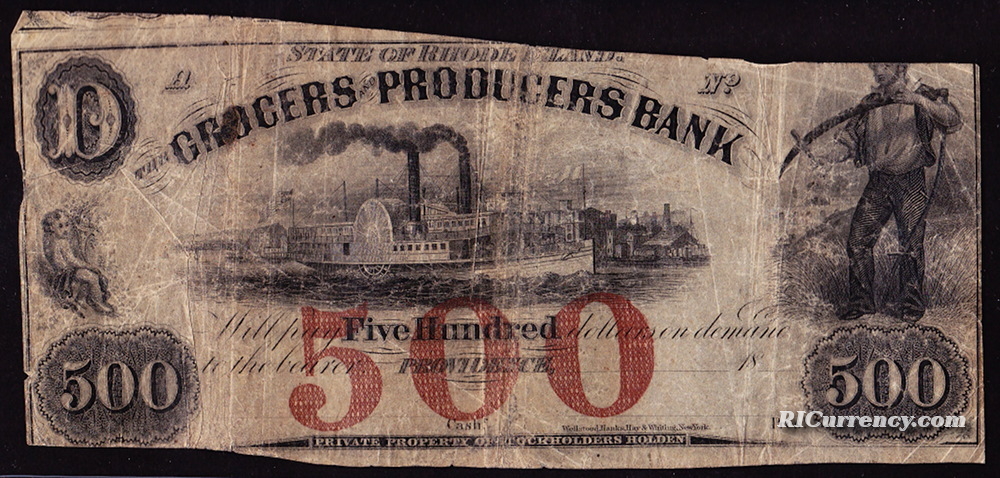

Charter of the bank from 1853.
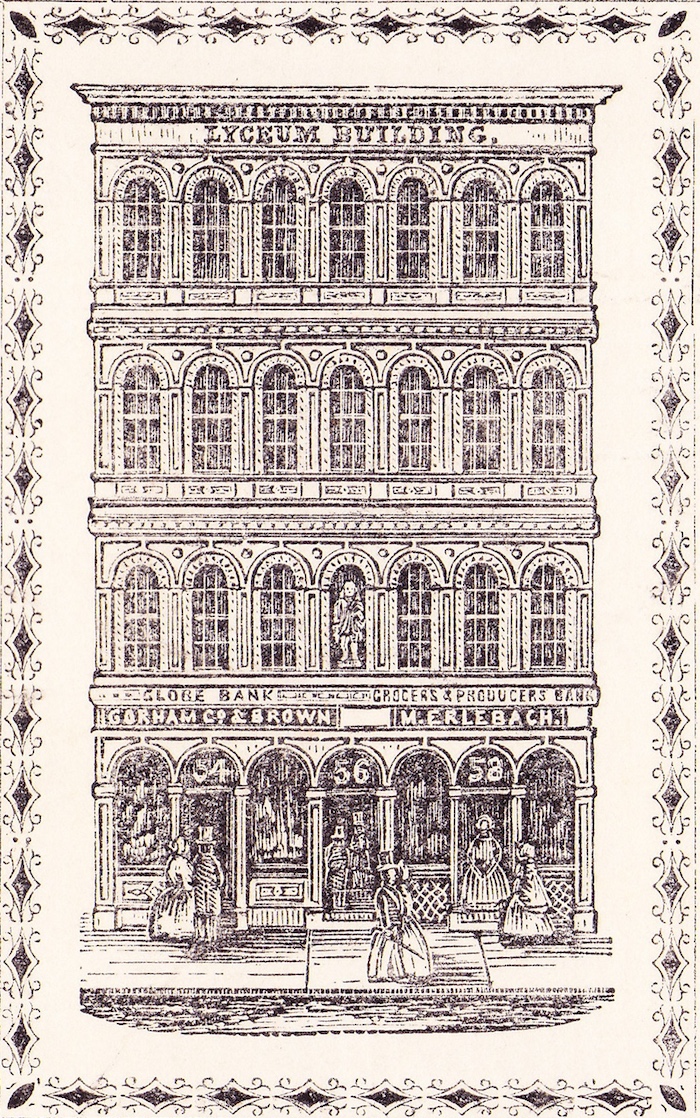
The Grocers & Producers at the Franklin Lyceum Building, 56 Westminster Street. Also occupied by the Globe Bank. Completed in November, 1858, this structure was home to the Franklin Lyceum. It had a large statue of Benjamin Franklin on its façade. Demolished in 1926 to make way for the new Providence National Bank building, when the lot was number 90. The statue of Benjamin Franklin was moved to the Old Stone Bank building on Empire Street (now the Pell Chafee Performance Center).
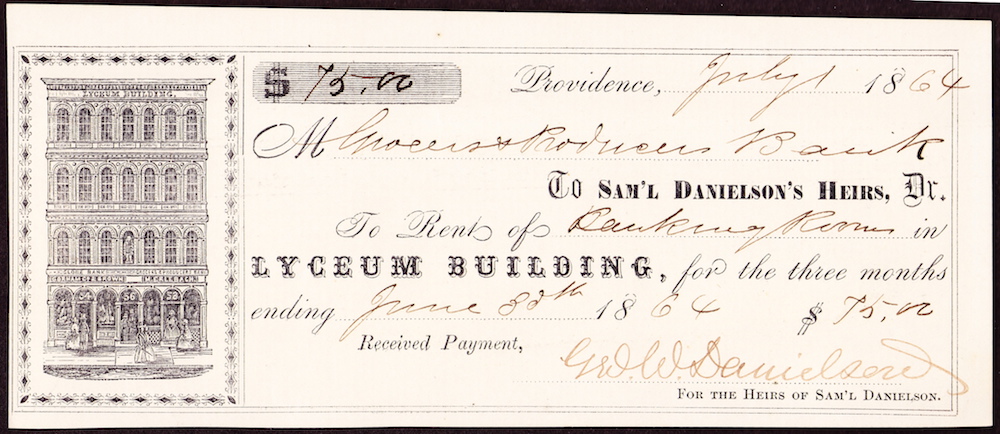
According to this receipt, Grocers & Producers paid $25 a month in rent for their banking rooms in the Lyceum Building. It was owned by the heirs of Dr. Samuel Danielson.
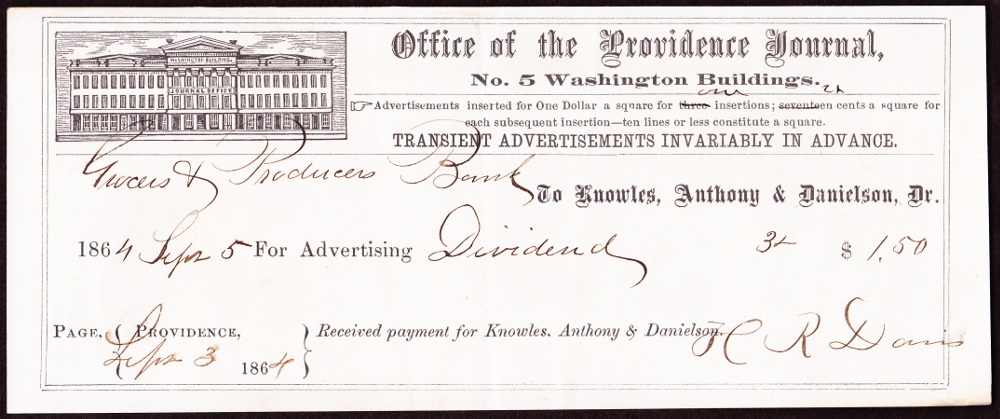
Receipt for advertising in the Providence Journal. Dated September 5, 1864. They paid $1.50 for three ads listing the bank’s dividend.
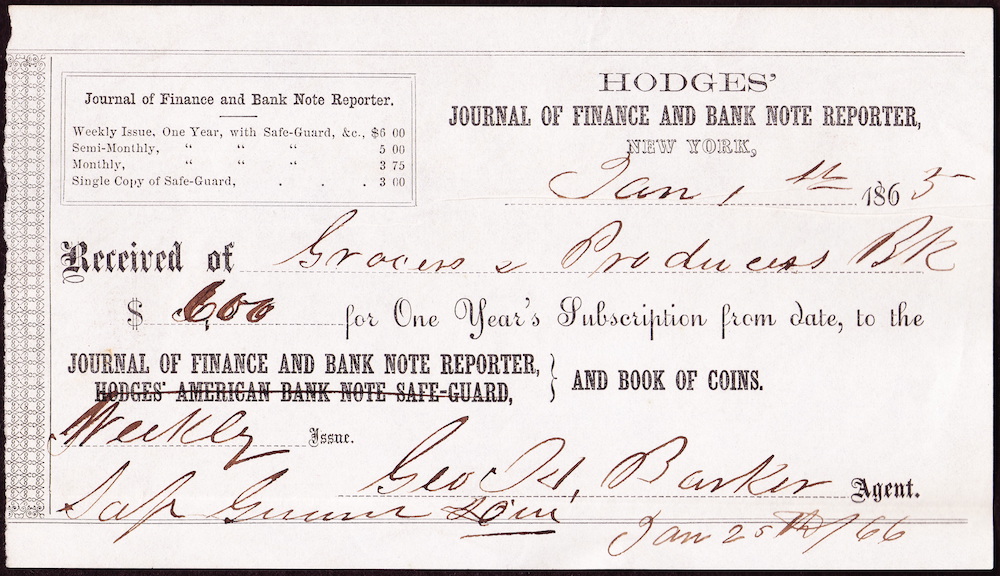
Journal of Finance and Bank Note Reporter, which cost $6 for one year of weekly issues. ” width=”1000″ height=”576″ class=”size-full wp-image-10328″> Receipt dated January 1, 1865 for a subscription to Hodges’ Journal of Finance and Bank Note Reporter, which cost $6 for one year of weekly issues.

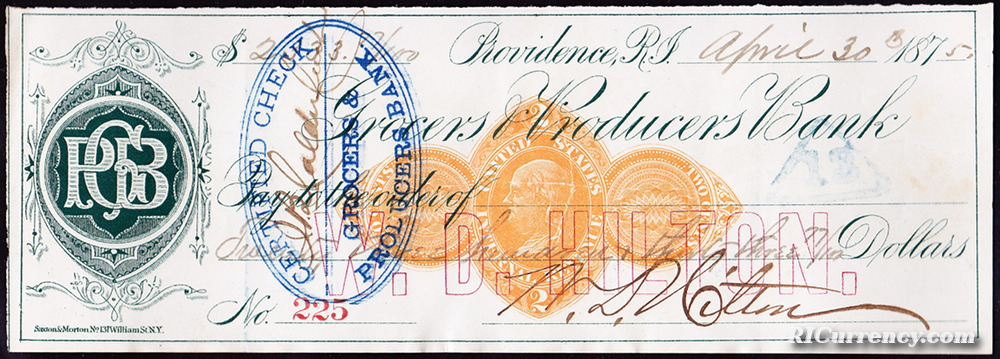
A bank check certified by John B. Calder (his signature is in the vertical blue stamp).
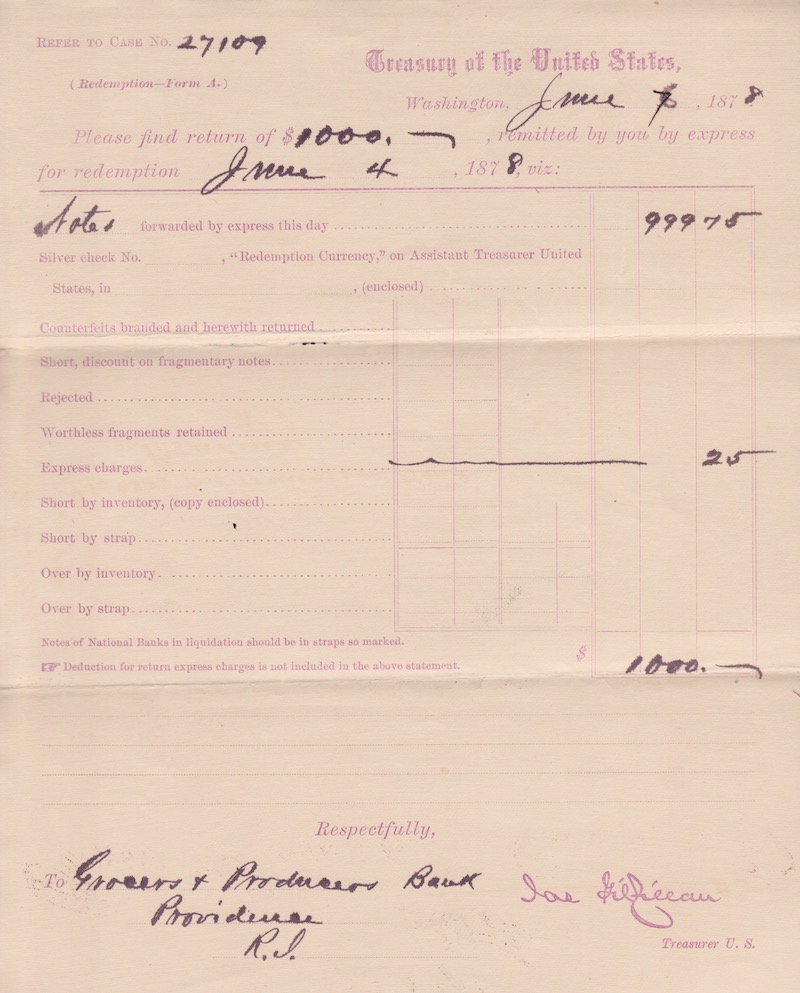
A letter from the US Treasury Department dated June 4, 1878, requesting $1,000 in bank bills be redeemed (minus 25 cents for express shipping).
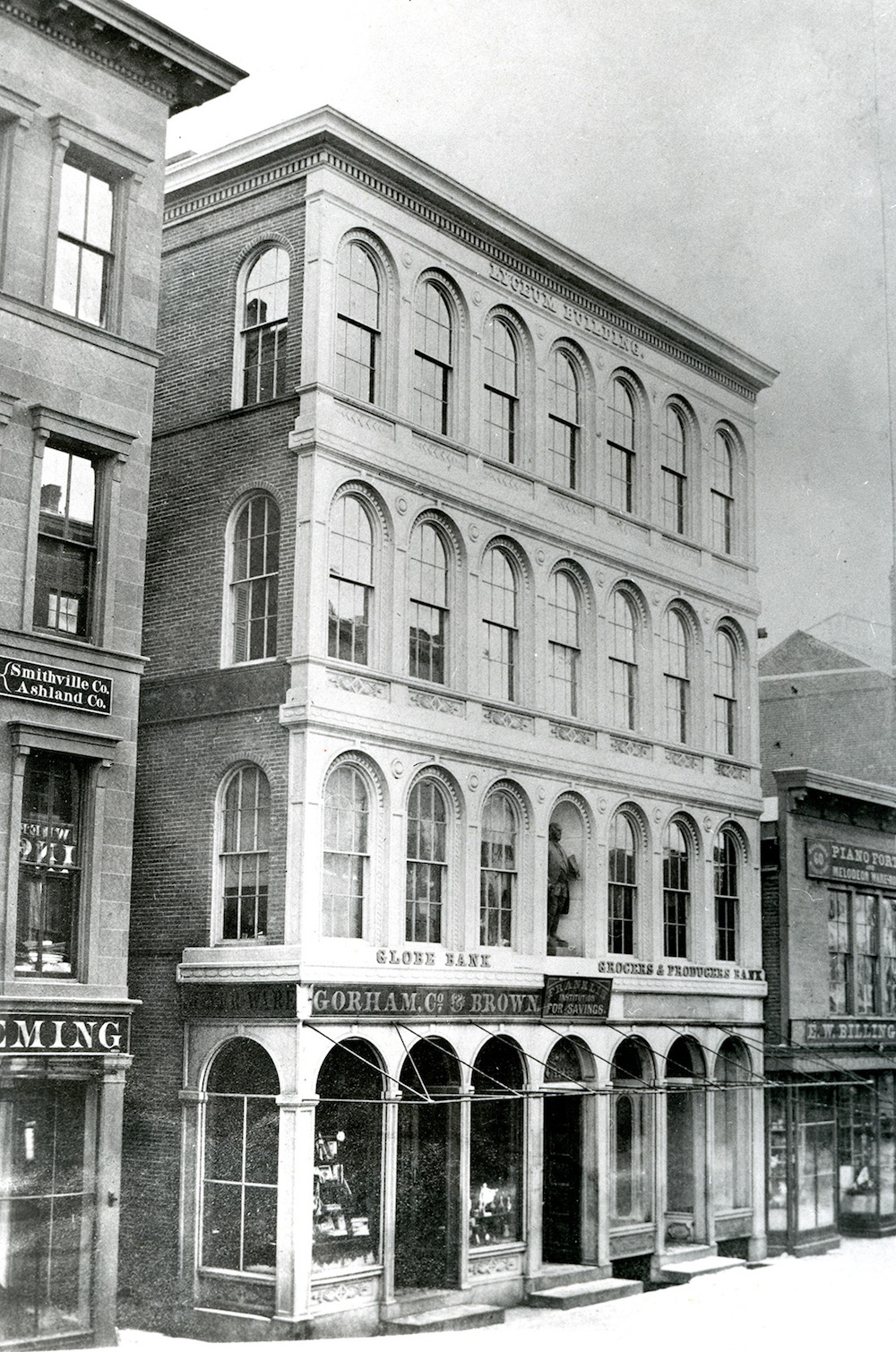
C. 1860s-70s photo of the Lyceum Building on Westminster Street with bank offices on the second floor.
“Lyceum Building”, VM013_WC0938, Rhode Island Photograph Collection , Providence Public Library, Providence, RI. Reprinted with permission.
